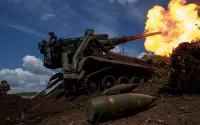Al Ahram
I might as well admit to one of my shameful little secrets. I've enjoyed the Indiana Jones film series. And since I'm baring all, you might as well know: I doubt if I've missed a single James Bond movie (ever since way back when the still dashing Sean Connery was doing it, up to the current hero, whose name I don't recall). But then, I tend to be highly tolerant of my various (human) failings -- not to mention everyone else's. The Indiana Jones film I have in mind was possibly one of the most blatantly racist films ever produced by Hollywood, which is saying a whole lot, especially when the object of racism, as in this film, happens to be Arab (make that Arabs -- all of them). Most of the action is supposed to be taking place in 1930s Cairo, where, amazingly, the army of the Third Reich holds sway. Cartoon, you may say, but how many, I wonder, among the film's American audience, not least George W himself, actually came out of the theatres fully convinced that Egypt was under Nazi German rule in the 1930s (our imperial masters' arrogance, after all, is equalled only by their enormous ignorance of the world they insist on "leading" -- by the nose)? I remember little of the film; there is a final grisly scene where Old Testament God meets Hollywood and kindly melts the skin and flesh off the German soldiers' bones. One scene, however, has stayed firmly in my mind. Indiana Jones is being attacked by various turbaned and robed "Arabs" in a Cairo souq, which is borrowed from a mediaeval Baghdad souq, as portrayed in a '50s Hollywood version of a tale from A Thousand and One Nights. Indiana Jones (a younger and less haggard Harrison Ford) kicks and punches his way through half a dozen of these evil-looking baddies and, finally, the worst of them all appears on the scene. The earlier fighting has cleared the middle of the souq, and it is in this space that the American hero and his villainous Middle Eastern-featured antagonist face off. Dressed all in black, including the inevitable turban, the hook-nosed "Arab" wields a mean curved sword. He prances and preens, his sword twisting and swerving elegantly. We've been cued. Our Hollywood-conditioned neurons rush through our brains: we anticipate one of those semi-climactic swashbuckling scenes, which used to take our breath away when we were kids but tend to bore us as we grow older. Here is where the hero comes this close to having his throat slit, but ultimately, surprisingly yet predictably, prevails. But here is where the filmmakers have their little joke on us. There will be no swashbuckling scene: Indiana Jones nonchalantly pulls his pistol out and shoots the villain dead. I was watching the film along with an old friend (a film director, as it happened), and we fell about laughing. There was instant recognition; despite the racism and imperial arrogance, we could actually identify with the prancing and preening villain, whose absurd death ("martyrdom"?) seemed to encapsulate one of the salient features of the modern political history of the Arab world. Neurons leapfrogged over cultural boundaries and, in our minds, the racist imperial slur became a typical Egyptian joke (Egyptians are invariably the butt of their own most vicious jokes). The grand Arab battle for the liberation of Palestine was summed up: we prance and preen; the Israelis (the ultimate embodiment of half a millennium of Western imperialist oppression and plunder), silently and coldly, shoot -- and kill. I can't remember exactly when or where we saw Raiders of the Lost Ark (it was released in 1981), but the scene was definitely being replayed in my mind in 1990-'91, while Saddam Hussein was threatening to use his "double-barrelled" chemical war-heads to bomb Israel into oblivion. Iraqi "steadfastness" lasted only for as long as it took the US-led coalition to finish "bombing Iraq back to the Middle Ages." It ended as soon as the ground war began. Thankfully, and pathetically, the chemical war-heads never got off the ground. "I wish to declare that if America used chemical or nuclear weapons against us, then we may retort with chemical and nuclear weapons. We have the weapons as a deterrent," Osama Bin Laden told a Pakistani journalist the other day. Typically, the White House's first reaction was that it was taking Bin Laden's threat "seriously." Within the week, Kabul had fallen. Major historical events are repeated twice, said Hegel. Marx, writing on the 1851 coup d'état of Louis Bonaparte, agreed, adding that the first time occurs as tragedy, the second as farce. In the Arab world, we've managed to best them both. For a people who have lived the full tragic cycle of Nasserism, which reached its zenith in the June '67 debacle, it should have been impossible to fall for Saddam's 1990 farce. Yet fall we did. Still, the wheel does not cease spinning; farce is repeated as greater farce, repeated as even greater farce. We began with the heroic figure of Gamal Abdel- Nasser, the nationalisation of the Suez Canal, Bandung, Afro-Asian solidarity and the Non-Aligned Movement. Now we have Bin Laden, the Taliban and the World Trade Center. How low can you go? Leaders preen and prance. People, from Palestine to Afghanistan, continue to die. "Where are you Salaheddin? The nation awaits you." The huge banner hanging from the downtown headquarters of the Bar Association hits me in the face on my way to work every day. Is it not time that we stopped waiting for a saviour? They're becoming more clownish and absurd with every passing day.






